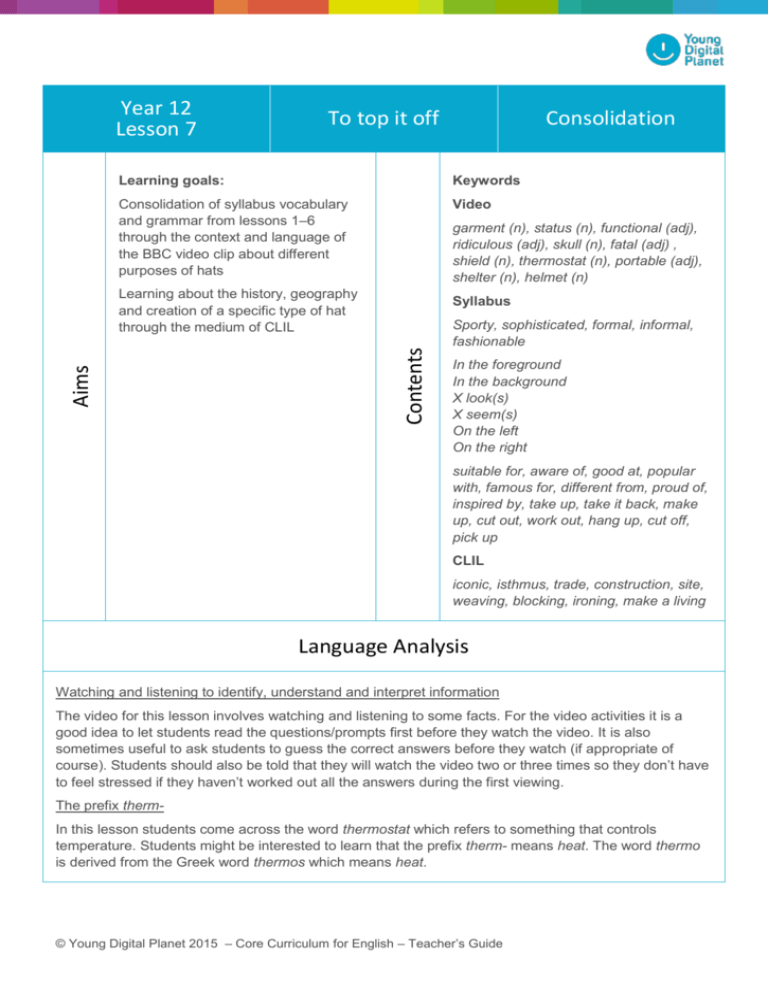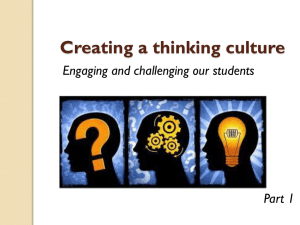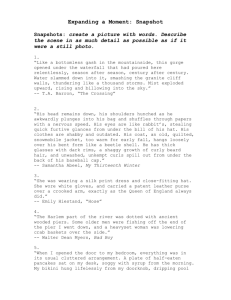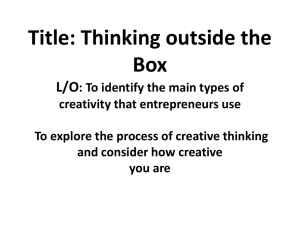Young Digital Planet 2015 – Core Curriculum for English
advertisement

Year 12 Lesson 7 To top it off Consolidation Learning goals: Keywords Consolidation of syllabus vocabulary and grammar from lessons 1–6 through the context and language of the BBC video clip about different purposes of hats Video garment (n), status (n), functional (adj), ridiculous (adj), skull (n), fatal (adj) , shield (n), thermostat (n), portable (adj), shelter (n), helmet (n) Syllabus Contents Aims Learning about the history, geography and creation of a specific type of hat through the medium of CLIL Sporty, sophisticated, formal, informal, fashionable In the foreground In the background X look(s) X seem(s) On the left On the right suitable for, aware of, good at, popular with, famous for, different from, proud of, inspired by, take up, take it back, make up, cut out, work out, hang up, cut off, pick up CLIL iconic, isthmus, trade, construction, site, weaving, blocking, ironing, make a living Language Analysis Watching and listening to identify, understand and interpret information The video for this lesson involves watching and listening to some facts. For the video activities it is a good idea to let students read the questions/prompts first before they watch the video. It is also sometimes useful to ask students to guess the correct answers before they watch (if appropriate of course). Students should also be told that they will watch the video two or three times so they don’t have to feel stressed if they haven’t worked out all the answers during the first viewing. The prefix thermIn this lesson students come across the word thermostat which refers to something that controls temperature. Students might be interested to learn that the prefix therm- means heat. The word thermo is derived from the Greek word thermos which means heat. © Young Digital Planet 2015 – Core Curriculum for English – Teacher’s Guide Other everyday words/phrases that contain this prefix are: thermometer: an instrument that measures levels of heat. thermos flask: an insulated bottle that people use to keep things warm. thermal garments: special garments that are designed to retain heat. © Young Digital Planet 2015 – Core Curriculum for English – Teacher’s Guide Procedure Lead-in Key: 1 to top something off – finish something with a final activity or detail. 2 garment – item of clothing 3 functional – useful 4 ridiculous – silly 5 skull – bone that protects the brain 6 fatal – causing death 7 shield – something that protects part of your body 8 thermostat – something that controls temperature 9 portable – easy to move or carry 10 shelter – place that protects you from the weather Ask students to look at the words. Explain that they will hear them in the video clip. Tell students to think about what they mean and then match them with their definitions. Extension: Go around the class and ask students to say a sentence using a word from the list. © Young Digital Planet 2015 – Core Curriculum for English – Teacher’s Guide Video Part 1 Video: To stay on top of fashion you need to use your head. Hats are signatures of personality, subtle messages of status and garments of belief. Whether they are functional or just plain ridiculous, you are never fully dressed without a hat. The head is the casing of mission control. An organ so vital it must be protected. Damage to the skull could prove fatal so the helmet is employed as a shield. A faithful companion in even the most extreme activities. Sporting hats play many important roles. Protecting the player and offering him support. 70 % of body heat is actually lost through the head. But a hat can serve as an effective thermostat keeping us warm in winter and cool in the sun. Hats are the portable shelters that protect against all the elements. Key: 1b2a3b4c5a Tell students to watch Part 1 of the video clip and choose the correct answers. Then ask them to work in pairs and check their answers. © Young Digital Planet 2015 – Core Curriculum for English – Teacher’s Guide Video Part 1 Video: To stay on top of fashion you need to use your head. Hats are signatures of personality, subtle messages of status and garments of belief. Whether they are functional or just plain ridiculous, you are never fully dressed without a hat. The head is the casing of mission control. An organ so vital it must be protected. Damage to the skull could prove fatal so the helmet is employed as a shield. A faithful companion in even the most extreme activities. Sporting hats play many important roles. Protecting the player and offering him support. 70 % of body heat is actually lost through the head. But a hat can serve as an effective thermostat keeping us warm in winter and cool in the sun. Hats are the portable shelters that protect against all the elements. Key: 1 garments 2 organ 3 fatal 4 helmet 5 head 6 warm, cool 7 shelters Ask students to watch Part 1 of the video clip and choose the correct answers. Then tell them to work in pairs and check their answers. © Young Digital Planet 2015 – Core Curriculum for English – Teacher’s Guide Video Part 2 Audio: Tribal people don colourful and elaborate hats, headwear that reveals the wealth and the status of the wearer. In modern cultures too, hats often hold the key to social standing. Shrouding their owner in crowning glory. Hats are also worn as badges of belief, designs dictated by religion. Covering a head shows loyalty to a faith and brings joy at festival time. The humble hat completes a uniform at school or in industry advertising the wearer’s trade and skills. And when the work is done the hat becomes an object of momentous celebration. From caps to crowns the hat has long been the peak of fashion. Perhaps the most famous is the bowler. In over a hundred years this simple hat has become a true British institution. Dignified men were once never seen without a hat. And even today the topper remains an essential finishing touch for the distinguished gentlemen. For fashionable women the hat symbolizes style and sophistication. And at important social gathering only the most flamboyant stay on top. To keep ahead of style millaners strive to create new designs. Drawing inspiration from worldwide traditions and tastes. Every outfit begs to be topped off with a hat. Fashionable, stylish or just simply outrageous, there is a hat for every occasion. Ask students to watch Part 2 of the video clip and choose True or False. Then tell them to work in pairs and check their answers. Key: 1T2F3T4T5F6F7T8F © Young Digital Planet 2015 – Core Curriculum for English – Teacher’s Guide Video Part 2 Audio: Tribal people don colourful and elaborate hats, headwear that reveals the wealth and the status of the wearer. In modern cultures too, hats often hold the key to social standing. Shrouding their owner in crowning glory. Hats are also worn as badges of belief, designs dictated by religion. Covering a head shows loyalty to a faith and brings joy at festival time. The humble hat completes a uniform at school or in industry advertising the wearer’s trade and skills. And when the work is done the hat becomes an object of momentous celebration. From caps to crowns the hat has long been the peak of fashion. Perhaps the most famous is the bowler. In over a hundred years this simple hat has become a true British institution. Dignified men were once never seen without a hat. And even today the topper remains an essential finishing touch for the distinguished gentlemen. For fashionable women the hat symbolizes style and sophistication. And at important social gathering only the most flamboyant stay on top. To keep ahead of style millaners strive to create new designs. Drawing inspiration from worldwide traditions and tastes. Every outfit begs to be topped off with a hat. Fashionable, stylish or just simply outrageous, there is a hat for every occasion. Tell students to watch Part 2 of the video clip and choose the correct answers. Then tell them to work in pairs and check their answers. Key: 1 wealth 2 belief 3 bowler 4 men 5 world 6 outfit © Young Digital Planet 2015 – Core Curriculum for English – Teacher’s Guide Follow-up 1 Key: Picture of a golfer – golfer in baseball cap Picture of man in flat cap – man in flat cap Picture of coloured top hats – top hat Profile of orange hat – orange hat Picture of black feathery hat – black feathery hat Picture of white glove hat – rubber glove hat Tell students to look at the photos of hats. Ask them to match them with the descriptions. Then put students in pairs. Tell them to describe a photo of a social event to their partner. Get them to use the prompts to help them. Extension: Choose some pairs to share their descriptions with the class. © Young Digital Planet 2015 – Core Curriculum for English – Teacher’s Guide Follow-up 2 Key: 1 suitable for 2 aware of 3 good at 4 popular with 5 famous for 6 different from 7 proud of 8 inspired by Tell students to complete the sentences. © Young Digital Planet 2015 – Core Curriculum for English – Teacher’s Guide Follow-up 3 Key: 1 take up 2 take it back 3 make up 4 cut out 5 work out 6 hang up 7 cut off 8 pick up Tell students to complete the sentences with the words from the box. © Young Digital Planet 2015 – Core Curriculum for English – Teacher’s Guide Content and language consolidation Key: Where are Panama hats made? – Ecuador, in South America. Why is Panama such an important area for trade? – Because it's the narrowest point in all of the Americas. What are Panama hats like? – Strong, lightweight and light-coloured. Who else was responsible for making Panama hats popular? – President Theodore Roosevelt of the USA. What processes are involved in making Panama hats? – Weaving and blocking. When were they first called 'Panama' hats? – In the mid-19th century. What are Panama hats made of? – The leaves of a type of grass. Which groups of people helped to make Panama hats popular? – Miners and construction workers. Tell students to look at the pictures. Ask them if they know what kind of hat it is and where it comes from. Elicit some answers and then tell © Young Digital Planet 2015 – Core Curriculum for English – Teacher’s Guide them to read and match the questions and answers. © Young Digital Planet 2015 – Core Curriculum for English – Teacher’s Guide Lead-out Key: Students’ own answers. Put students in pairs. Tell them to ask and answer questions about Panama hats. Monitor and feed in ideas if necessary. © Young Digital Planet 2015 – Core Curriculum for English – Teacher’s Guide Production Key: Students’ own answers. This is a ‘free practice’ stage. The aim is personalisation. Give out a copy of the Handout and give students the following instructions: Find out about another type of hat – what it is like, where it comes from, how/why it became popular, how it is made. Make notes under the headings below, then write a short paragraph about it. You may need to allow students access to the library or internet to find out the required information. Extension: Choose some students to read their paragraphs to the class. Then hold a class discussion. Ask students: Which type of hat would you like to wear? Encourage students to give reasons for their answers. © Young Digital Planet 2015 – Core Curriculum for English – Teacher’s Guide Handout Type of hat What is it like? Where does it come from? How/why did it become popular? How is it made? © Young Digital Planet 2015 – Core Curriculum for English – Teacher’s Guide





